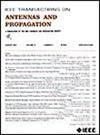Millimeter-Wave Radar-in-Display for Target Characterization and Micro-Doppler Sensing
IF 5.8
1区 计算机科学
Q1 ENGINEERING, ELECTRICAL & ELECTRONIC
引用次数: 0
Abstract
This article presents a novel millimeter-wave (mmWave) frequency-modulated continuous-wave (FMCW) radar-in-display (RiD) concept for target characterization and micro-Doppler sensing. The radar system comprises one transmitter and three receivers, integrated along the nonoptical dead space (DS) (毫米波显示雷达用于目标表征和微多普勒传感
本文提出了一种新的毫米波(mmWave)调频连续波(FMCW)显示雷达(RiD)概念,用于目标表征和微多普勒传感。雷达系统包括一个发射器和三个接收器,沿显示面板边缘的非光学死区(DS) ($300~\mu $ m)集成。对于二维扫描,一个接收(RX)天线位于垂直边缘,而另外两个与发射器一起放置在水平边缘。陷波单极天线安装在垂直边缘,电容耦合槽偶极天线安装在水平边缘。基于馈电不对称性,设计了狭缝偶极子与安装在垂直DS上的单极子天线对极化。将天线集成到显示面板中并连接到射频集成电路以实现RiD原型。通过各种手势实验验证了原型,并通过后处理后的频谱图显示了距离,微多普勒频移,方位角和仰角。在后处理中提出了一种新的校正过程,以纠正由非常规阵列配置、近场效应和雷达部件引起的相位误差。结果表明,RiD系统能够以3 cm和0.19 m/s的分辨率捕获不同的手势特征。
本文章由计算机程序翻译,如有差异,请以英文原文为准。
求助全文
约1分钟内获得全文
求助全文
来源期刊
CiteScore
10.40
自引率
28.10%
发文量
968
审稿时长
4.7 months
期刊介绍:
IEEE Transactions on Antennas and Propagation includes theoretical and experimental advances in antennas, including design and development, and in the propagation of electromagnetic waves, including scattering, diffraction, and interaction with continuous media; and applications pertaining to antennas and propagation, such as remote sensing, applied optics, and millimeter and submillimeter wave techniques

 求助内容:
求助内容: 应助结果提醒方式:
应助结果提醒方式:


